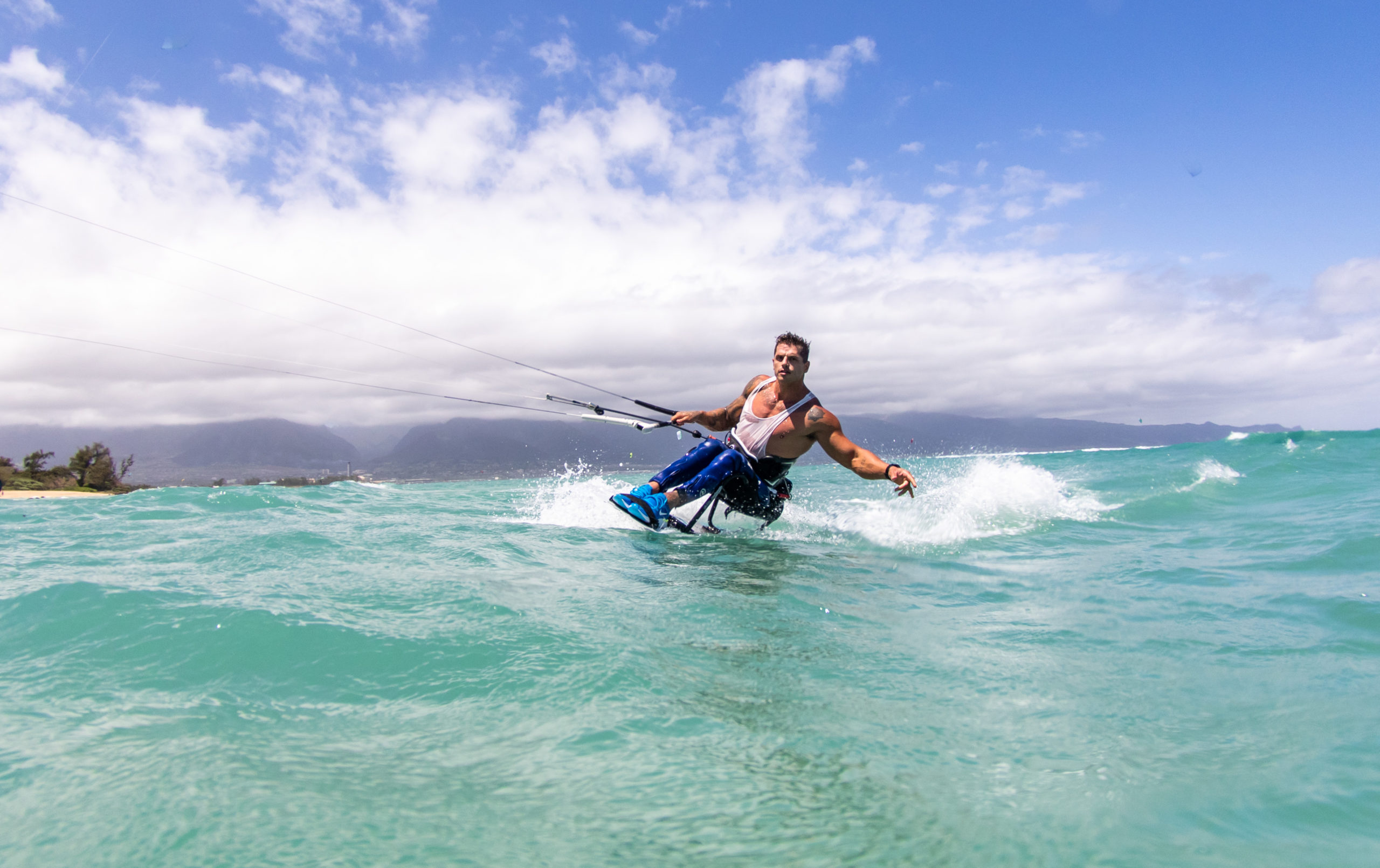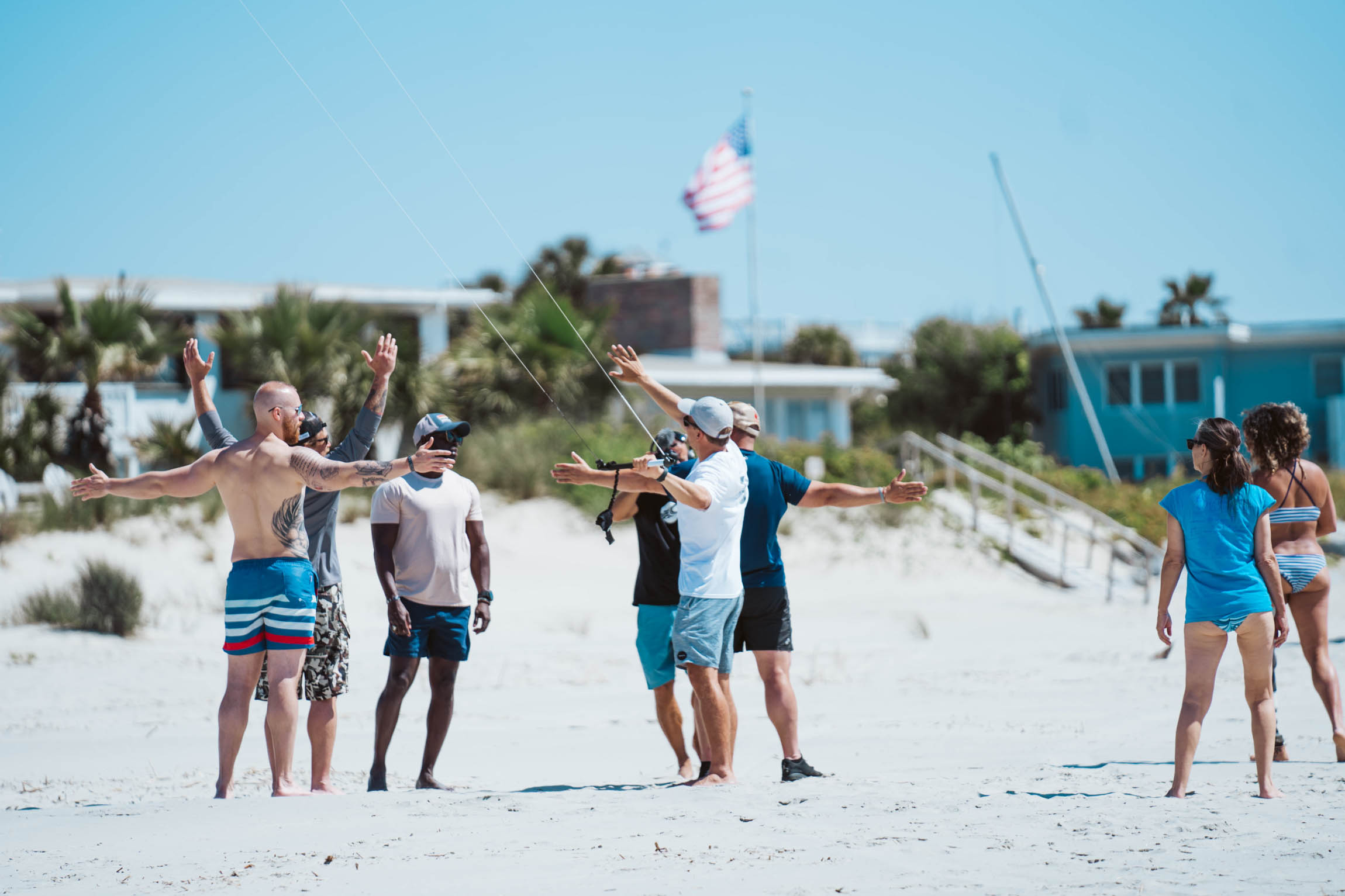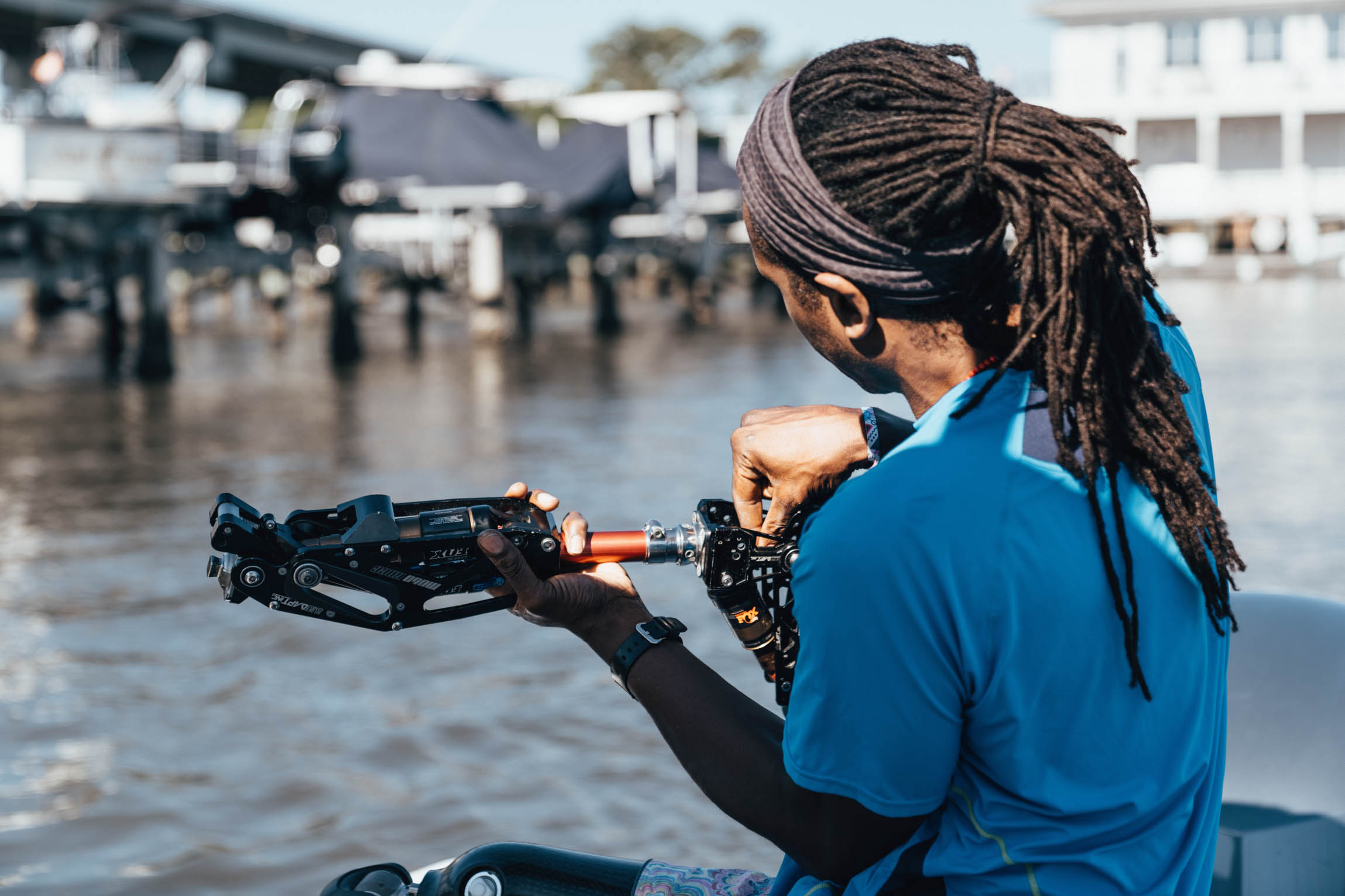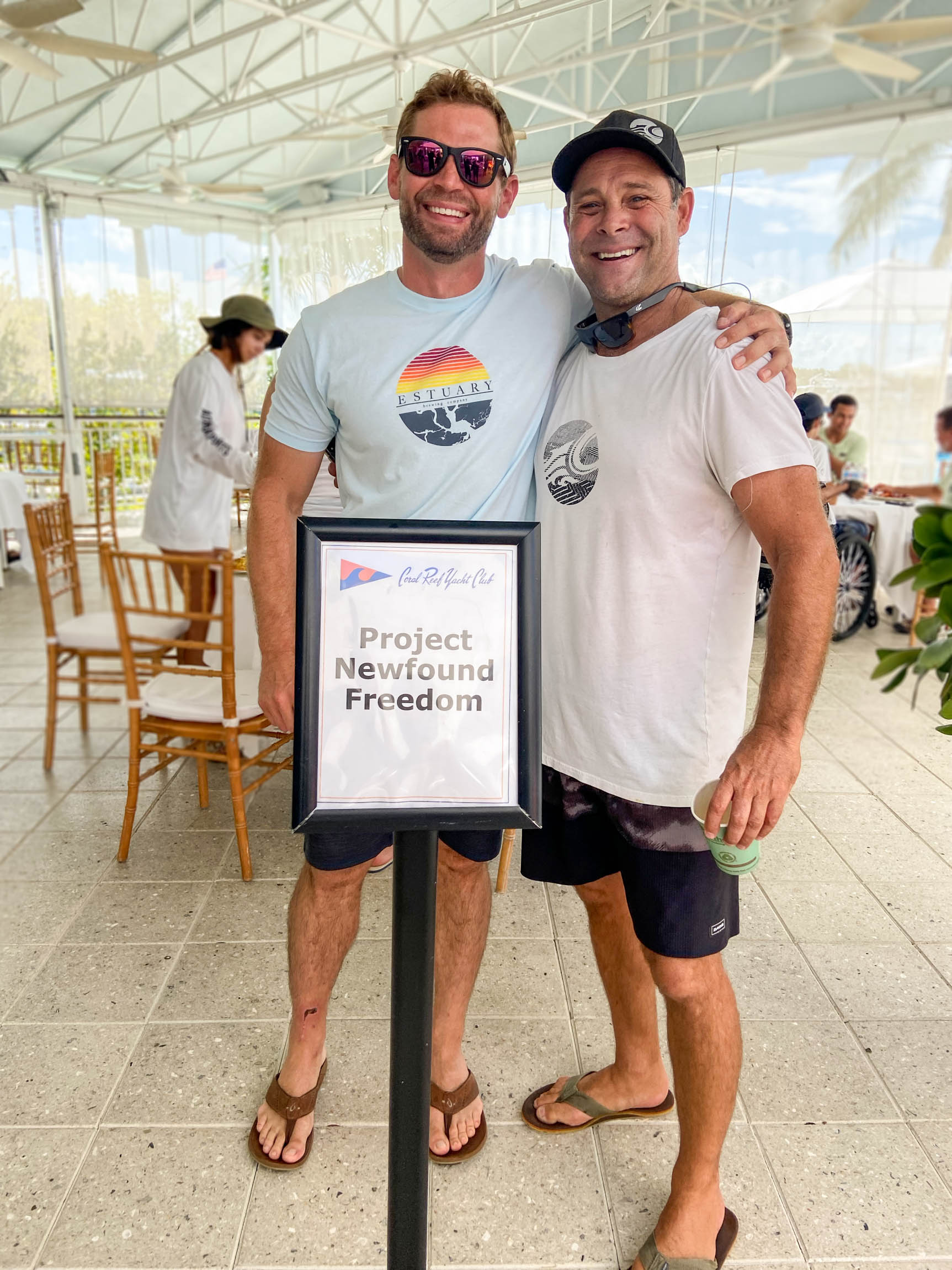 Everyone deserves their adrenaline fix, Kent says as he palms a six-pack of Drifter beer and explains how the Cabrinha partnership with Estuary Brewing is a vehicle for expanding kiteboarding access to individuals that might never encounter the life-altering stoke of kiting. For Cabrinha CEO Kent Marinkovic and the rest of the Cabrinha team, creating an adaptive program for kiteboarding from scratch would not be easy; in fact, it would take hundreds of man-hours and wads of cash, but the lofty ambitions of the Newfound Freedom project’s first phase have generated incredible progress for opening up kiteboarding to an entirely new group of users who face either physical or mental challenges. From day one, kiteboarding has always had an access problem. When the first production kites hit the market in 1998””with only two lines, zero depower, and no quick release””kiting was an extreme undertaking built specifically for risk-taking thrill-seekers. In the following two decades, brands like Cabrinha have chiseled away at the safety issues, with improved release systems and groundbreaking designs like the first supported leading-edge high-depower kite that revolutionized the entire industry. Today’s state of kiteboarding safety allows everyone, from young kids to your adventurous grandma, to take a lesson and give the pull of kites a go. Despite the broadening market, until recently, kiteboarding has offered little progress in the way of adaptive programs like the ones you might find in skiing or snowboarding. While other sports have invested in pathways for onboarding those with athletic challenges, kiteboarding has yet to direct its attention to those who have the desire to learn but need assistance and specialized equipment. Having worked with Brazilian paraplegic Fernando Fernandes to build a custom sit-board, Cabrinha was at the forefront of oneoff adaptive innovations, but for Kent Marinkovic, supporting a single athlete wasn’t moving fast or far enough.
Everyone deserves their adrenaline fix, Kent says as he palms a six-pack of Drifter beer and explains how the Cabrinha partnership with Estuary Brewing is a vehicle for expanding kiteboarding access to individuals that might never encounter the life-altering stoke of kiting. For Cabrinha CEO Kent Marinkovic and the rest of the Cabrinha team, creating an adaptive program for kiteboarding from scratch would not be easy; in fact, it would take hundreds of man-hours and wads of cash, but the lofty ambitions of the Newfound Freedom project’s first phase have generated incredible progress for opening up kiteboarding to an entirely new group of users who face either physical or mental challenges. From day one, kiteboarding has always had an access problem. When the first production kites hit the market in 1998””with only two lines, zero depower, and no quick release””kiting was an extreme undertaking built specifically for risk-taking thrill-seekers. In the following two decades, brands like Cabrinha have chiseled away at the safety issues, with improved release systems and groundbreaking designs like the first supported leading-edge high-depower kite that revolutionized the entire industry. Today’s state of kiteboarding safety allows everyone, from young kids to your adventurous grandma, to take a lesson and give the pull of kites a go. Despite the broadening market, until recently, kiteboarding has offered little progress in the way of adaptive programs like the ones you might find in skiing or snowboarding. While other sports have invested in pathways for onboarding those with athletic challenges, kiteboarding has yet to direct its attention to those who have the desire to learn but need assistance and specialized equipment. Having worked with Brazilian paraplegic Fernando Fernandes to build a custom sit-board, Cabrinha was at the forefront of oneoff adaptive innovations, but for Kent Marinkovic, supporting a single athlete wasn’t moving fast or far enough.

Fernando Fernandes ripping his custom Cabrinha sit-board. // Photo James Boulding
One of the fundamental truths of kiteboarding is that it brings people together and inspires them to make changes in their lives. When Florida businessman, retired Navy Seal and obsessed kiteboarder Mike Noell invited Kent on a Bahamas boat trip, the seeds of Newfound Freedom were all but sewn. As a successful entrepreneur, Noell has a knack for pulling people together, and on this excursion, he invited Scott Harrison, a decorated retired member of the US Army Special Forces and owner of Estuary Brewing Company. Fresh off the stoke of his first kiteboarding experience, Scott fixated on the endorphin hit of gliding over the water with the pull of a kite. Over beers on the open waters, Scott shared with Kent his personal struggle to find a positive activity that replaced the adrenaline rush of serving in the armed forces. Having attached himself to sailing, Scott now fixated on the potential of kiteboarding to help other veterans, wounded or healthy, transition to civilian life. Together they sketched out an idea to bring the magnetic and stabilizing forces of kiteboarding to individuals going through some of life’s most challenging hurdles. Scott and Kent imagined a program that would combine and leverage their organizations’ strengths and resources and open up kiteboarding to a broader group, not just to those in the military, but to anyone confronting physical and mental challenges. In the months that followed, Scott circled back with Kent and they began to piece together the Newfound Freedom project. As a longtime force in the Cabrinha family, Kent has always wanted to build grassroots outreach programs that spread kiting to groups outside its core demographic. Last year, after having been acquired from a foreign-based large portfolio of action sports companies, Cabrinha gained its own ”˜newfound freedom’ and is now owned and operated by core investors that are deeply committed to the culture of kiteboarding. With its new priorities in place, the Cabrinha staff now has the ability to pursue meaningful projects that complement the company’s longstanding commitment and roots in the industry.


Newfound Freedom instigators: Cabrinha CEO Kent Marinkovic on the left and Estuary owner Scott Harrison on the right.// Photos Shelby Ring
The goal of the Newfound Freedom project was to share the life-changing therapeutic experience of kiteboarding with individuals navigating physical or mental challenges. The events would take a lot of human capital to get off the ground, but more importantly, they would need money. Although both Cabrinha and Estuary Brewing were financially committed to the endeavor, they needed a charitable source of revenue that would sustain the project. This is where the Drifter beer concept was born. Estuary began brewing a small batch of beer featuring Keahi smacking the lip on its label and the proceeds from each can sold would go towards funding the Newfound Freedom project. “The Drifter is an easy-drinking lager,” says Cabrinha’s Sales Manager Brendan Healy, “You can put down a bunch of them, and they’re really refreshing on a hot day.” With distribution on its way, kiters can support the Newfound Freedom project by purchasing Drifter beer as far east as Boston, Miami and Charleston and as far west as Hood River and Southern California. With no overhead or salaries penciled into the program, Scott and Kent have been very clear that proceeds from the sales of the Drifter beer will go directly to funding outreach to challenged individuals.


LEFT: The Estuary Brewing staff shows off the Drifter Coast to Coast Lager, soon to be available outside of Charleston in select locations around Boston and Miami and as far west as Hood River and Southern California. // Photo Shelby Ring RIGHT: Keahi is getting shipped around the world again, this time on the label of a beer can. // Photo Shelby Ring
The Newfound Freedom project wasn’t created as a single event, but as a broader ongoing program aimed at helping to initiate and support the ongoing participation of individuals with disabilities in the sport. Tying together the strengths of Cabrinha’s dedicated staff, athletes and equipment engineers along with looping in the popularity of Estuary Brewing’s small-batch brewing model, the two companies devised a three-phase plan to reach these goals.

Newfound freeriders use their arms to locate the wind. // Photo Shelby Ring
The first phase consists of hosting a series of events that invite challenged individuals to experience kiteboarding. Participants apply to attend the programs, and Newfound Freedom puts them up and uses each event as a vehicle to provide basic learning skills. From Kent’s point of view, the events are a valuable tool to learn about adaptive kiteboarding techniques and the equipment needed to expand the sport to a broader audience. Phase two, as Kent imagines, will take Cabrinha’s equipment innovation team and use it to create adaptive products based on what they learn in phase one. The third phase will plug the new equipment and teaching methods into Cabrinha’s kite centers around the world to create destinations for adaptive kiteboarders. According to Kent, “Selfishly, this is a good move for Cabrinha; we want to make more customers,” he laughs, but Kent knows that when you convert one person into kiteboarding, you get the chance to bring in the kids, husbands, wives and other family members. Kiteboarding is, by its nature, an addictive force, and it has the potential to be a family affair. The three-phase plan ensures that participants get more than just a taste of kiteboarding””it’s designed to create a pathway of support to onboard and convert those with challenges into dedicated and obsessed kiteboarders.


LEFT: Bringing all the toys, the Crosswing gave participants an immediate feel for the wind. // Photo Shelby Ring RIGHT: Bradley Johnson learns the trick for uncrossing lines. // Photo Shelby Ring
The first Newfound Freedom event kicked off in Charleston, South Carolina, the hometown of Estuary Brewing’s headquarters. Cabrinha brought in its top athletes, Keahi de Aboitiz, Evan Netsch, Damien Leroy, Kit Griffiths and Lucas Arsenault, to teach the participants along with vital support staff from the Florida office. Cabrinha’s export manager, Frances Osorio Rivera, was one of the biggest inspirations for Newfound Freedom. As an amputee herself, she absolutely rips on the water with backroll hand drags and big airs and has a passion for helping others find their way into the sport. Having been told she’d never kite again after her accident, Frances broke the barrier, and with determination, relearned to kite with one leg, a feat she hopes to help others overcome. Frances is a cornerstone of the project, bringing substantial experience with instruction to the events as well as her extensive connections to the amputee community. In Charleston, Frances shared her kiteboarding passion with Bradley Johnson, one of the program’s most eager members, who lost both his legs in a tragic car accident but has gone on to become a talented Paralympic sailor. With his long dreads and big, bright smile, Bradley first dialed in his kite control with the trainer kite. He was all geared up for his first body drag when the wind faded, and instead, he gave hydrofoiling behind a boat a try.


LEFT: Showing more signs of fun than fear, Bradley Johnson guns the eFoil. // Photo Becca Healy RIGHT: Evan Netsch explains the basic concepts. // Photo Shelby Ring
Evan Netsch had the chance to work with military veteran Todd Berrios, who mastered the trainer kite in just a couple of hours. Having suffered multiple gunshot wounds, Todd had lost some mobility in one arm and hand which caused some issues with swimming during his body drag. Evan recalls, “I pushed him pretty hard, but given his personality, I think he appreciated that.” Todd recounted to Evan his background in an elite squadron that handled intense combat situations, constantly pushing limits and confronting fear. Feeling the power in the kite and body dragging brought back that challenge and rush of adrenaline since Todd had not been able to push himself outside his comfort zone since the injury. “Some of us are injured and we can’t find that adrenaline rush anymore. Getting pulled in the water by the kite . . . made me feel like this was something I could absolutely do to find that challenge in life again.” According to Evan, “He’s committed to continuing the learning process, and that is what’s cool about kiteboarding; you can push your limits on your first day, and even after decades of riding, it always gives you the ability to challenge yourself and learn something new.” If Cabrinha had initial worries about finding participants for the Newfound Freedom events, that immediately resolved itself with a flood of applications from both the military and civilian worlds. The second event held in Miami was planned around light wind, but the Cabrinha crew came prepared with a towboat, eFoils and a donated house in Stiltsville to stage the event. Kent was amazed at what he learned from Steven Ruiz, a local paraplegic. Bound to a wheelchair, using adaptive hand gloves, Steven was able to fly a trainer kite as well as ride an eFoil with Kent and Damo stabilizing the board. Kent laughs when recalling how Steven saw people jumping off the deck of the Stiltsville house and asked to try. “His first jump wasn’t pretty”” it was a full faceplant, and he was underwater for half a second longer than I would have preferred, but he came up so damn happy.” Sometimes adaptive programs can feel really formal and technical, but Kent’s goal was to make Newfound Freedom feel like friends teaching friends and sharing the camaraderie of the authentic kiteboarding experience together.
“Kent saw how bicycle components like shocks and clipless pedals could be used to solve control and connection issues”

Bradley Johnson’s prosthesis borrows tech from a number of sources that might be equally helpful to adaptive kiteboarding. // Photo Shelby Ring
After just two events, Cabrinha’s staff has already identified several equipment development goals. With every participant experiencing different and unique challenges within kiteboarding, the Cabrinha staffers were able to highlight problems for the engineering team to solve. Witnessing some of the prosthetic equipment firsthand, Kent saw how bicycle components like shocks and clipless pedals could be used to solve control and connection issues. Designers like Lars Moltrop and Brodie Sutherland have worked on developing custom sit-boards for Fernando Fernandes, but the Newfound Freedom project offers a whole new bucket of novel ideas to explore.

The Newfound Freedom instigators, Estuary Brewing owner Scott Harrison and Cabrinha CEO Kent Marinkovic, celebrate after two successful events. // Photo Becca Healy
Kent recently received a call from a Cabrinha store that sold a large package of hydrofoiling gear to a customer building a tandem hydrofoil board. In the process of tracking that down, Kent is finding a lot of outside sources of inspiration for creating a more formal adaptive kiteboarding segment. With Cabrinha’s design resources and its newly acquired Dakine windsports partnership, it has the people-power to make everything from proper harnesses and accessories to the actual equipment that will expand the kiteboarding experience far and wide. There is also a shared optimism among the staff that the lessons learned in catered adaptive gear will undoubtedly prove useful in building gear for the broader kiteboarding market.
Scott and Kent are excited to take the Newfound Freedom to the west with a Hood River clinic tentatively scheduled for September 8-10th, while a fourth event in Maui is also in the works. With Drifter beer production ramping up and distribution landing the lager in new spots across the country, Estuary has created a convenient way for people to channel their drinking money back into kiteboarding.
Not satisfied by single-serve experiences, Cabrinha has created a pipeline that expands the reach of kiteboarding to people with challenges. As a pioneer in the realm of kite racing, Kent is known as an incredibly competitive person, and in that regard, he hopes that Cabrinha’s investment in adaptive kiteboarding will encourage other brands to get into the game. Newfound Freedom ups the ante beyond single athlete sponsorships and puts the spotlight on building effective programs that broaden the sport’s reach and spreads the adrenaline stoke to the people that need it the most. Newfound Freedom is bottling something that most kiters know well; kiteboarding is a great fix for anyone willing to experiment with the therapeutic pulling power of the wind.

This article was featured in our summer 2021 issue, Vol. 18, No. 2. To read more, click here.

